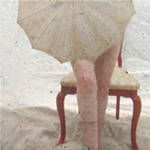‘Testsite 06.1 ~ The Burden of Decision: Two Exercises in Collaboration’
'Testsite 06.1 ~ The Burden of Decision' is an investigation of artistic collaboration with a strong current of Freudian repression and struggle running below the surface
Reviewed by Nikki Moore, Fri., April 28, 2006
Testsite 06.1 ~ The Burden of Decision: Two Exercises in Collaboration
Testsite, through May 7
All right ladies and gentlemen, let's begin with a little game: I'll say a word or phrase, and you say the first thing that comes to mind. For example, I'll say, "institutional authority," and you'll respond with something like "father." Or I'll say, "Testsite 06.1 ~ The Burden of Decision," and you'll say, "artistic collaboration working through repression." At the end of the game, we will be on par, not only with a long-standing trend in conceptual art investigations, but also with Fluent~Collaborative's latest test site, created by Blanton Museum of Art Assistant Curator for the Latin American Collection Ursula Dávila Villa and conceptual artist Carla Herrera-Prats.
On the surface of things, "Testsite 06.1 ~ The Burden of Decision" has nothing to do with father figures, repression, or Freud, for that matter. On the surface of things, the project is an investigation of artistic collaboration itself – a look at what it takes to collaborate, who is involved, and how institutions and cultures of all sorts play a role. For their collaboration, Herrera-Prats and Dávila Villa drew on Herrera-Prats' current archival work. Entering Fluent~Collaborative's own library, they found volume after volume by an artist I'll call X. He has a name, a method, and a history, but for the sake of this test site, Lawrence Weiner's identity (oops, I let that slip) functioned as the identity of any author. Looking at Weiner as tool, Herrera-Prats and Dávila Villa adopted the methodology of the artist's own approach to collaboration, but not its content: meaning that they turned to, and the exhibit itself displays, the acknowledgment pages of Weiner's books to see the way that collaboration had been noted in his own projects, drawing on both the institutional and personal nature of these acknowledgments. Next, Herrera-Prats and Dávila Villa asked permanent members of the Fluent~Collaborative institution to formally contribute to their own collaboration by writing short articles on any aspect of the project they were interested in, engaging the Fluent staff as agents (à la Weiner's acknowledgees) while, again, placing little value on the actual content of their collaborative contribution, as it was the sheer act of collaboration that was important.
Yet, below the surface of a collaborative project on collaboration, is a real Oedipal complex shared by this artist-curator pair and many conceptual artists. Lurking in the subconscious of projects like Herrera-Prats and Dávila Villa's is a declarative coup on the Father and Host (in this case, Fluent~Collaborative), who is making this project possible. The coup manifests in the uncovering of the repressed in the artists' collaborative relationship through this investigation of collaboration itself. The process and the result is an Oedipal struggle of the children (Herrera-Prats and Dávila Villa) against the father (Weiner, Fluent co-founder Laurence Miller, Fluent~Collaborative, and the institutionalization of the artistic practice) in order to possess the mother – who is the nature of artistic collaboration itself, always just out of reach of the artist and curator who try to pin her down. While the result is Freudian ecstasy, it is also an intensely interesting test site, where repression, collaboration, art, and institutionalization endlessly work themselves through in the way that art, even art therapy, does best.










